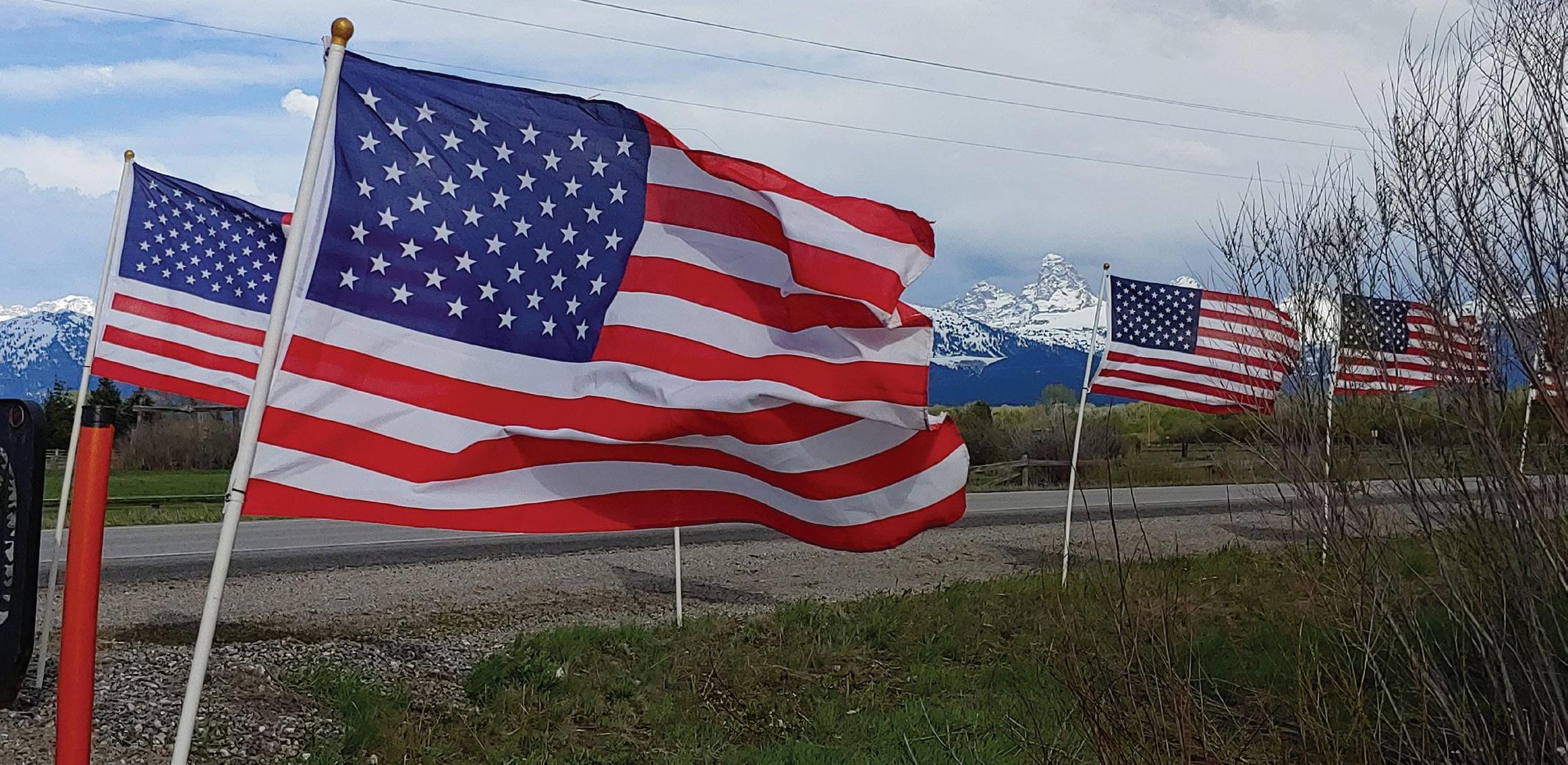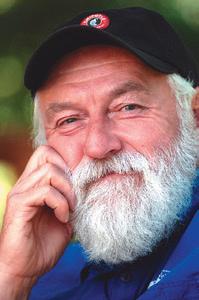

Ruralite
Main Street sparkled Nov. 30, 2023, for Hermiston’s Holiday Lighted Parade, with Umatilla Electric Cooperative and others lighting up the night in festively decorated vehicles.
PHOTO BY ROBERT LUKE PHOTOGRAPHY












































































A New Kind of Police Work



by Andrew Cutler

Police officers spend much of their career dealing with the negative society throws at them. So when something positive comes along, they embrace it.


That’s exactly what the officers of the Hermiston Police Department do each year with its Christmas Express program, a regular Hermiston tradition now in its 56th year. Local organizations and community members join the police to provide toys and food to less-fortunate families in Hermiston.
“Well over 90% of what a police officer deals with every day is negative, in the sense people don’t call us when something good is happening,” Hermiston Police Chief Jason Edmiston said. “Throughout your career, you’re constantly looking for little things to either make the day or justify your existence.”
Community Partnerships
The program, which costs approximately $22,000 annually to operate, relies heavily on community support. Local service organizations like Rotary contribute between $8,000-$12,000 annually, while individual community members quietly make substantial donations.
“I’m born and raised here in Hermiston, and it wasn’t until I started this program that I realized how generous our local farmers are,” Edmiston said. “There’s not a farmer I can’t call in a bind and say, ‘I need this, can you help me out?’”
The community’s generosity comes in many forms. Local farmers provide fresh produce, including potatoes and onions. Some donors prefer to remain anonymous, like one family that contributes $4,000 each year to help fund the program.
The COVID-19 pandemic brought new challenges, particularly in securing bulk food orders, but the community adapted. When Walmart changed its bulk ordering policies, other local businesses stepped up.
“Harvest Foods over in Umatilla has really stepped up and helped us out by just identifying, ‘We can get you 500 turkeys,’”
School Spirit


Edmiston said. “I don’t necessarily like the cost, but it is what it is.”

One of the program’s key partnerships is with the Hermiston School District, whose students conduct annual food drives to help stock the holiday food boxes and whose counselors help identify families who could use a boost.


“We work with the schools on identifying the people and then each individual school may or may not hold a canned food contest,” Edmiston said. “Whatever the top class that they identify, we do gift cards, and we do $125 for elementary schools and then $150 for the top class from the two middle schools and then the high school.”
The friendly competition between classes has helped forge a strong bond between the police department and the school district, making the partnership a cornerstone of the program’s success.
“The Hermiston School District is delighted to once again partner with the Hermiston Police Department for this annual canned food drive,” Maryanna Hardin, the school district’s communications officer, said. “This partnership has been a longstanding tradition, one that the Hermiston School District is proud to support year after year.”
Hardin said Christmas Express embodies the spirit of the season — bringing the community together to support families in need.
“We’re excited to see the enthusiastic participation from each of our schools,” she said. “We look forward to witnessing the unity and generosity of our students, staff and families as they join together in the spirit of giving.”
Feeding Families
That generosity helps provide approximately 100 pounds of food to each family, including a turkey, along with presents for
Hermiston Police Department’s Christmas Express marks 56 years of bringing holiday cheer to local families

the warranty. Generous manufacturer warranties demonstrate the company’s confidence in the quality of its products.
Finally, because most smart appliances are connected to the internet, make sure you think about privacy and security. Research the manufacturer’s privacy policies and security features to ensure data —like your voice commands and shopping habits—don’t fall into the wrong hands. Making sure the manufacturer takes your privacy and online safety as seriously as you do is a smart strategy.
For most homeowners, the biggest downside to smart appliances is they carry higher price tags than their not-so-smart counterparts. However, price is just one factor in the cost of any appliance. When you also consider the long-term value smart appliances deliver—whether that’s in energy savings, helpful conveniences or improved reliability—most save you money over their service life.
Smart appliances may be eligible for rebates and tax incentives, so ask your retailer what’s available.
What’s ahead for smart appliances in the foreseeable future? The marketplace is starting to see the integration of basic artificial intelligence capabilities that can make smart appliances provide better service, greater reliability and lower energy needs. As these AI-fueled systems become more common, your refrigerator might know your habits so well it can generate a shopping list for you. Your dishwasher could adjust its operating cycle to better clean your family’s uniquely dirty dishes.
There was a time when appliances changed little from decade to decade. Today, products advance more quickly than ever before, and we can expect to see more big changes ahead. n

BY
Shop Wisely and Be an Energy Star
By Jennah Denney
As the days grow colder, you may be considering ways to stay cozy while also managing home energy use. One of the best ways to make your home more energy efficient is by choosing products with the Energy Star label. But what exactly does the label mean, and how can it benefit you?

How Products Earn the Energy Star Label
Energy Star is a program by the U.S. Department of Energy and the Environmental Protection Agency to help consumers identify energyefficient products that save money and reduce environmental impact.
Products that earn the Energy Star label must meet strict guidelines for energy efficiency, performance and cost effectiveness. Here’s how the process works:
The product must be more energy efficient than typical models. This helps you save on energy bills by using less electricity while still providing the same performance.
The product must be tested in EPA-recognized labs following standardized procedures. These tests ensure the product meets all energyefficiency and performance requirements.
Once tested, the product’s data is reviewed by a third-party certification body to verify it meets the set standards. This ensures only the best products receive the Energy Star label.
Even after a product is certified, the EPA conducts off-the-shelf testing on random samples of Energy Star products to ensure they continue to meet the required standards. If a product fails to meet the performance requirements during verification testing, it can be disqualified from the Energy Star program. The EPA has clear procedures for handling such disqualifications to maintain the integrity of the label.
Speaking of Labels
Whether you’re upgrading your refrigerator, replacing lightbulbs or buying new electronics, the blue Energy Star label is your assurance the product has passed all energy-efficiency tests. It’s easy to spot and can be found on products ranging from small and major appliances to electronics.
Many large appliances, such as washing machines and clothes dryers, include a yellow Energy Guide label that provides estimated energy use. Comparing these labels can help you determine how much you can save with an Energy Star model compared to a standard model.
While Energy Star products can cost a little more upfront, their energy savings over time often cover the difference. They help reduce your household energy consumption, which could translate to lower utility bills.
As you shop for appliances, electronics or other home equipment this holiday season, look for the Energy Star label. Whether it’s a new washing machine or energy-efficient lighting options, these products are a simple and effective way to save money and lower energy use. Check with your electric utility about rebates or incentives for buying Energy Star products.
To browse products that have earned the Energy Star® label, visit www.energystar.gov.

Make your home more energy efficient by choosing products with the Energy Star label.
PHOTO
MIKE GATTORNA
ADOBE







Warmth for Winter: UCARE Heating Assistance
As your local electric cooperative, we’re committed to not only keeping the lights on but also to caring for our community, especially as winter approaches. We know the colder months and heating expenses can strain household budgets, and we’re here to help.
The UCARE program, supported by member contributions and matched by Umatilla Electric Cooperative, provides direct assistance to those facing high energy costs. Available during the heating season from October through March and the cooling season from June through August, UCARE funds help lowincome residents manage heating and cooling expenses. These funds supplement federal assistance programs through CAPECO, giving our members added support.
During times of crisis, UCARE also extends help to any UEC member who encounters an emergency—be it personal, medical, or employmentrelated—ensuring they have the assistance needed to maintain electric service.
If you’re finding it difficult to keep up with your bill, reach out to us. Alongside UCARE, we offer

payment extensions to give you extra time to pay your electric bill if you’re experiencing financial difficulties. By discussing options, we can help you pay what you can, so you don’t accumulate a large pastdue balance. Whether you connect with us by phone, in person, or online, we’re here to support you.
For more about available payment options, energy efficiency programs, or the UCARE payment assistance program, call us at (541) 567-6414 or visit our website, UmatillaElectric.com.
Use your phone’s camera to scan the QR code at right to learn more about the UCARE Energy Assistance Program:















































Taking Stock
Breeding program preserves heritage livestock
By Les O’Dell
Denise Hanna’s herd of cattle looks different from others seen near her Etna, California, ranch. That’s because they are different. That distinction is what first attracted her to belted Galloway cattle, and that’s why they draw so much attention.
Belted Galloways—informally known as “belties”—are best known for their appearance: usually black (although sometimes red or roan) with a wide, white belt running vertically between the shoulder and hind legs, leading some to refer to the breed as “Oreo cows.” Looks aside, the breed is known for its efficiency on rough forage, being good mothers and producing high-quality beef.
The cows are among a wide variety of heirloom breeds of agricultural livestock— animals once common across the United States but now considered endangered.
Known as heritage breeds, they are a throwback to a time before industrial agriculture became a mainstream practice.
According to The Livestock Conservancy, a North Carolina-based not-for-profit organization working to promote and protect these animals, heirlooms are breeds that were carefully selected and bred over time to develop traits that made them welladapted to the local environment. The breeds thrived under farming practices and cultural conditions that are very different
from some found in modern agriculture. Because of unique characteristics such as slower rates of weight gain, these breeds fell out of favor with commercial producers, pushing some of the old breeds to the brink of extinction.
Today, The Livestock Conservancy lists more than 180 agricultural breeds across 11 species—ranging from rabbits, ducks and geese to cattle, horses and pigs—on its Conservation Priority List, an annual report ranking the danger of disappearance of each breed. The classifications are critical, threatened, watch, recovery and study. Based on these rankings, conservationists work to preserve these breeds.
Denise shares the organization’s mission when she speaks to those who ask about her Belted Galloways.
“I talk about how they are a heritage breed, and there are not as many of them,” she says, explaining the uniqueness of the breed and quality of the beef she sells online. “I’ve been very pleased with the taste of the beef. I find that they don’t need as much marbling to be tender and taste great.”
Across the country, more than 4,000 volunteer breeders and 150-plus breed associations work to ensure endangered breeds like belted Galloways—ranked under the “watch” category on the conservation list—don’t disappear. Homesteaders and farmers choose heritage breeds for a variety of reasons. Some,

including Rex Studyvin of Jerome, Idaho, are attracted to the uncommon breeds.
Rex’s farm includes milking Devon cattle (listed as critical), Jacob-American sheep (threatened) and mule-foot hogs (critical). He says many of the characteristics of heritage breed animals— such as resistance to some parasites and diseases or ability to pasture in less-thanideal settings—may prove to be valuable over the long term.
“They have genetics that we don’t want to lose because if those genetics are gone and we need them, we will have problems,” he says.
Denise Frye of Addy, Washington, calls it “maintaining genetic diversity for the future.” She got into raising a variety of chickens, turkeys, ducks and geese through an interest in permaculture.
“Permaculture is basically a lifestyle that incorporates sustainability into all of its principles, and heritage livestock certainly fills the bill in that regard,” Denise says.
Denise has been recognized for her work in conservation breeding of the cotton patch goose, which moved from critical to threatened on the 2023 list. She established the Cotton Patch Goose Society to further promote and protect the breed a dozen years ago.
The protection of biodiversity and genetic resources are other important reasons for protecting these breeds, says Alison Martin, program director for The Livestock Conservancy. Many producers

American flags along the side of the road each Memorial Day and Independence Day. With the cooperative’s help, they plan to keep Trent’s flags flying for years to come.
“I feel like I’m very blessed that he worked for them,” Betsey
says. “They didn’t have to be as good to us as they were, considering he had worked there for barely 30 days. The fact that they would put my son into this fund, that they would be willing to do that for him, meant a great deal to me.”
A Gift for the Future
For Cooperative Family Fund Board President Tony Anderson, providing support for each member of the cooperative family—no matter how long they have been part of it—is what Cooperative Family Fund is all about. The idea for the fund first came to Tony after a series of funerals for lineworkers across the country. He realized cooperative support often ends after the funerals.
“We’re really good at funerals in our business, but we don’t
If we care about our employees while they’re here at work, I don’t think that care evaporates when there is an untimely death.
— Bryan Case, Fall River Rural Electric Cooperative General Manager
do anything after,” he says. “We always talk about being a family in the co-op world, and I believe we’ve proven that over the years. But I felt this would make us a stronger family. And member services, engineers, accountants, managers—we’re all part of that family.”
Tony discussed the idea with other cooperative leaders and proposed it to the National Rural Utilities Cooperative Finance Corp. in January 2022. While there are no statistics on how many electric co-op employees are lost annually, the goal is to

Trent started a tradition of flying flags for Memorial Day and Independence Day, which Fall River Electric Cooperative will continue. PHOTO COURTESY OF THE SMITH FAMILY
Trent died after being on the job at Fall River Propane for only a month. PHOTO COURTESY OF THE SMITH FAMILY

ABOVE and OPPOSITE PAGE: Pages from a memory book created for Luke Hackman’s family after he died in 2022.
continually raise funds so any child younger than 18 who loses a parent employed by an electric co-op would receive a $10,000 trust. That trust accrues interest until the first day of the month after the child’s 18th birthday. At that point, recipients can put the money toward whatever they choose.
“Every child is going to take a different path or has different needs,” says Anne Harvey, one of the CFF founding board members. “If college education is something for them, rather than saying this is for books, maybe they need help with housing. The skilled trades are so needed at distribution co-ops, so maybe they want to go that route, or this could give them a gap year. Each child is going to have a different need, and we just can’t wait to see how they use the fund.”
In addition to encouraging cooperative staff to remain engaged with each family, Cooperative Family Fund also helps the cooperative put together a memory book of its time with the employee to give to family members. The books are an important inclusion for Tony, who was 2 when his father died. Tony has only a single photo of the two of them together.
“I have very few stories of him, less than five probably,” he says. “The memory book was important to me because I knew the kids would appreciate it over time. When you lose somebody, the biggest thing you’re worried about is people forgetting them. And when you give that family a memory book, they feel like their loved one is not forgotten because the memories are captured in that book.”
Healing Together
For cooperatives mourning the loss of one of their own, offering meaningful support to families has been just as important as the money. Hollee McCormick, general manager of AllamakeeClayton Electric Cooperative based in Postville, Iowa, recalls her team putting together a memory book for Luke Hackman. A member of the co-op’s broadband department, Luke died in a car accident the same month the Cooperative Family Fund
was announced. His two children were the first to receive trusts through the program.
“We were all grieving the loss of Luke, and putting that book together kind of had a healing effect for all of us,” Hollee says. “I always tell Tony there was so little we could do for that family. Being able to talk to his wife and tell her that the nation of co-ops had put this program together and we would be able to help a little bit more was meaningful.”
Brad Janorschke, general manager of Homer Electric Association based in Homer, Alaska, was supportive of Cooperative Family Fund when it officially launched in December 2022. What he did not expect was that his utility would need to make use of the fund just days later, when lineworker Sam Clyde was killed in a car accident, leaving behind five children.
“He was pretty much loved by everybody,” Brad says. “His picture is still in the hallway out of the office he worked at. His dad was a retired lineman for our utility, as well. It was fantastic that the fund was there. It really helped out the family, and now the cooperative contributes to it annually.”
While many participating co-ops donate through the board or give employees the chance to contribute from their paychecks, others have found ways to involve their communities. Flathead Electric Cooperative in Kalispell, Montana, held a cookie bake-off contest, and Beltrami Electric Cooperative in Bemidji, Minnesota, had a rummage sale. Proceeds from both events went to the fund.
Care That Continues
The fund has raised $1.2 million in its first two years and provided 78 trusts for the children of 37 employees across 20 states. Those numbers serve as a reminder of just how much the fund was needed, even to early supporters like Fall River Rural Electric Cooperative General Manager Bryan Case.
Oftentimes, co-ops are conscientious of the dangers of the job, Bryan says.

“But I don’t think we really understood the magnitude of workers who die for other reasons,” he says. “Maybe it’s cancer or a car wreck, and they leave children behind who are starting high school or elementary school. The need for that support is greater than I ever envisioned or anticipated.”
Cooperative Family Fund is looking for more ways to get co-op volunteers involved as the program grows. That might be enlisting more help putting together memory books or simply building a better network to alert fund leaders to families eligible for support.
“If we care about our employees while they’re here at work, I don’t think that care evaporates when there is an untimely death,” Bryan says. “This fund gives those underage children a little bit of a boost to get them on that next step, especially when there’s just one person at home now taking care of the whole family.”
That boost has been keenly felt by the Smith family, for whom money was tight even before Trent’s death. Whatever challenges they may face, it gives Betsey peace of mind to know Coleman will have a special gift from the cooperative family waiting for him on his 18th birthday.
“We didn’t really have college funds for our kids,” she says. “With five kids, we were just trying to keep the lights on most of the time. Setting aside extra money for things like that just didn’t happen. It’s very special and important to us that they’ve done that for us.” n



Luke Hackman died in a car accident and the Cooperative Family Fund provided trust money for his children. PHOTO COURTESY ALLAMAKEE-CLAYTON ELECTRIC
HOLIDAY BREAKFAST Make Ahead
Spiced Gingerbread Loaf With Orange Icing
2 cups all-purpose flour
1 teaspoon baking soda
11/2 teaspoons ground ginger
11/2 teaspoons ground cinnamon
1/4 teaspoon ground cloves
1/4 teaspoon salt
1/8 teaspoon fresh ground pepper
2/3 cup dark molasses

Recipes by Gertrude Treadaway
BY ZI3000
3/4 cup hot water (about 100 F)
8 tablespoons unsalted butter, softened to room temperature
1/3 cup packed light brown sugar
1 extra-large egg, at room temperature
1 teaspoon pure vanilla extract
1 cup powdered sugar, sifted
2 to 3 tablespoons orange juice
Heat oven to 350 F. Grease a 9-by-5-inch loaf pan. Set aside.
In a medium bowl, whisk together the flour, baking soda, ginger, cinnamon, cloves, salt and pepper. Set aside. In a separate bowl or dish, whisk together the molasses and hot water.
In a large bowl, using a handheld or stand mixer fitted with a paddle attachment, beat the butter on high speed until smooth and creamy, about 1 minute. Add the brown sugar. Beat on high speed for 1 minute until creamed together fairly well.
On medium-high speed, beat in the egg and vanilla extract until combined. With the mixer on low speed, add the dry ingredients in three additions, alternating with the hot water/molasses and mixing each addition just until incorporated. Avoid overmixing. The batter will be thin. Whisk out any big lumps.
Pour batter into the prepared pan. Bake for 50 to 60 minutes or until the loaf is baked through. To test for doneness, insert a toothpick into the center of the loaf. If it comes out clean with only a few moist crumbs, it is done. Set the pan on a wire rack, allowing the bread to cool completely before removing it from the pan.
To make the icing, whisk together the powdered sugar and orange juice. Drizzle over the cooled loaf.
ADOBE STOCK PHOTO






NORTH AMERICA’S









#1 Selling Walk-In

















The best walk-in tub just got better with breakthrough technology! Presenting the all new Safe Step Walk-In Tub featuring MicroSoothe. ® An air system so revolutionary, it oxygenates, softens and exfoliates skin, turning your bath into a spa-like experience. Constructed and built right here in America for safety and durability from the ground up, and with more standard features than any other tub.
✓ Heated seat providing warmth from beginning to end
✓ Carefully engineered hydro-massage jets strategically placed to target sore muscles and joints
✓ High-quality tub complete with a comprehensive lifetime warranty on the entire tub
✓ Top-of-the-line installation and service, all included at one low, affordable price You’ll agree – there just isn’t a better, more affordable walk-in tub on the market.
Joy To THE World
By Dave LaBelle
Every year, I create a folder on my computer desktop titled “Best Of,” where I place copies of my favorite images from the year. If it has been a good year, sometimes I end up with as many as 25 images in the folder, but usually there are 10 to 12. This process allows me to do a quick scan of pictures published or those I might want to do more with.


Recently, while looking through one of these folders from 2023, I was thinking about what I wanted to share this Christmas season— something joyful—and came across a photograph I made during a St. Patrick’s Day parade of a young man named Jake Wagner.
You might remember the name from a column I wrote about Special Olympics and giving of one’s time. Jake has Down syndrome. My heart leapt and my eyes watered as I revisited the first time I met this happy man.
Of the thousands I have photographed, few, if any, cause my heart to smile more than Jake.
Intelligent, loving and
caring, he embodies the pure, unpretentious joy I hunger to document and, more importantly, imitate. He is the greatest gift, the living Christmas card that brings me joy beyond description.
His mother, Betty, shared, “He is such a breath of fresh air. He is such a blessing. He has been making this world a better place since 1984.”
Holding his son’s hand, Jake’s father, Nick, agreed.
“He’s a very loving son,” he said. “He knows when you need a hug, too. He’s the best boy a father could have.”
When Jesus said, “Suffer the little children to come to me, for such is the Kingdom of God,” I am confident he had Jake in mind. n
NIKON D810, 180mm lens ISO 400, f/4.5 at 1/500
Reader Challenge
This Christmas season, see if you can capture a picture that brings you joy. It can be of happy children or grandchildren squealing with delight as they unwrap presents or somebody whose presence just makes you smile.
Email your best image (just one, please) with caption information, including an explanation of how it affects you, to GPH@pur.coop. We may share submissions on our website and social media channels.
Renowned author, photographer and lecturer
Dave LaBelle has captured special moments for more than half a century. For more of his writings, visit davidlabelle.com and bridgesandangels.wordpress.com.
Jake Wagner makes the world a better place thanks to his unrestrained love and joy. PHOTO
BY DAVE LABELLE









MonthlyNEWS

Timeline of Election
Fall 2024
2025 BOARD ELECTIONS
As a member, you have a voice in the direction of your cooperative.
Director Terms Expiring
Lee Docken District 1 Boardman
Jeff Wenholz
District 2 Irrigon
UEC’s Board of Directors appoints nominating committees for elections occuring the following Spring.
December 2024
In December, each nominating committee will meet to recommend candidates who are qualified to serve as a Director for their district, no later than Dec. 26, 2024.
(See details at right.)
January 2025
Nominations may still be made by petition. Deadline to file a completed petition is 6:00 p.m. on Feb. 3, 2025.
Spring 2025
Ballots will be mailed to members in Districts 1 and 2 who are qualified to vote. Ballots must be received by mail to the designated address printed on the ballot prior to the April 19 meeting to be counted.
Questions?
If you have any questions about the election process, please contact Katrina Ward at UEC at (541) 564-4388 for information.




UEC is a member-owned and locally controlled cooperative. The Board of Directors makes business and policy decisions in setting the direction of UEC. To ensure strong local leadership, members elect directors, on a rotating basis, from each of the seven districts.
Who Qualifies to Run for Office?
Any person who meets the following qualifications is eligible to serve as a Director of Umatilla Electric Cooperative (UEC). To qualify, applicants must:
• Be a bona fide resident in UEC’s service territory and reside in the district he or she wishes to represent. While either party of a jointly held membership may serve as a Director, the position cannot be shared by two people at the same time.
• Not be employed by, or financially interested in, a business selling energy or supplies to UEC.
• If previously employed by UEC, three years must have passed since date of separation.
Options to Qualify for the Ballot
NOMINATIONS BY COMMITTEE:
Each committee will recommend candidates who are qualified to serve as a Director for their district. If you wish to be considered by the appropriate Nominating Committee, please contact UEC at (541) 564-4388 as early as possible in December, and no later than the committee deadline on Dec. 26.
NOMINATIONS BY PETITION:
Potential candidates who are not named by the district nominating committee may submit a petition with the potential candidate’s name, voting district and at least 25 valid member signatures, as required, no later than 6:00 p.m. Feb. 3, 2025 at the UEC temporary modular office in Hermiston. After Jan. 2, call UEC at (541) 564-4388 for further information and blank petition forms.


Soup, Stews and Chowders
Get more than 220 recipes in a perfect-bound 8½-by-11-inch indexed book for $10, postage included.
BY MAIL: Send payment and number of cookbooks wanted, along with your name and address, to Ruralite Cookbooks, P.O. Box 1306, North Plains, OR 97133. BY PHONE: with Visa, MasterCard, Discover card or American Express.

Best Breads Cookbook
This 8½-by-11-inch indexed cookbook features yeast breads, quick breads, scones and specialty breads for $10 (includes postage).

TO ORDER BY MAIL: Submit payment with cookbook title, your name, address and number of cookbooks wanted to: Ruralite Cookbooks P.O. Box 1306 North Plains, OR 97133
TO PAY BY PHONE: Call 503-357-2105 for credit card payments with Visa, MasterCard, Discover or American Express.
TO ORDER ONLINE: Visit www.ruralite.com. Please allow two to three weeks for delivery.



